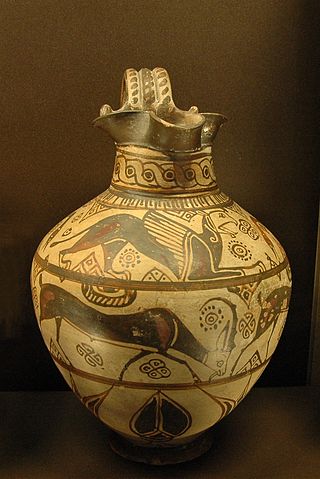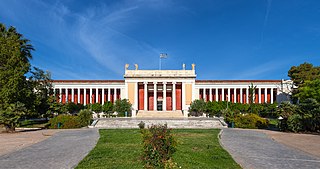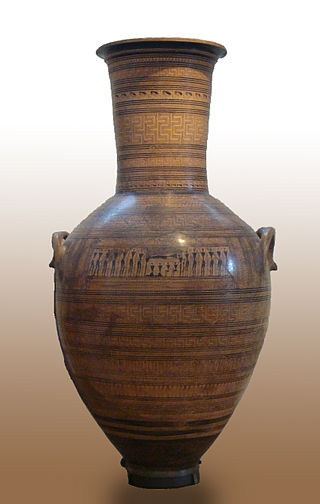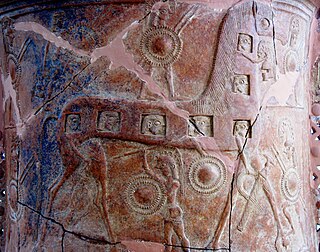
An amphora is a type of container with a pointed bottom and characteristic shape and size which fit tightly against each other in storage rooms and packages, tied together with rope and delivered by land or sea. The size and shape have been determined from at least as early as the Neolithic Period. Amphorae were used in vast numbers for the transport and storage of various products, both liquid and dry, but mostly for wine. They are most often ceramic, but examples in metals and other materials have been found. Versions of the amphorae were one of many shapes used in Ancient Greek vase painting.

In Greek mythology, the Trojan Horse was a wooden horse said to have been used by the Greeks during the Trojan War to enter the city of Troy and win the war. The Trojan Horse is not mentioned in Homer's Iliad, with the poem ending before the war is concluded, and it is only briefly mentioned in the Odyssey. But in the Aeneid by Virgil, after a fruitless 10-year siege, the Greeks constructed a huge wooden horse at the behest of Odysseus, and hid a select force of men inside, including Odysseus himself. The Greeks pretended to sail away, and the Trojans pulled the horse into their city as a victory trophy. That night, the Greek force crept out of the horse and opened the gates for the rest of the Greek army, which had sailed back under the cover of darkness. The Greeks entered and destroyed the city, ending the war.

Pottery, due to its relative durability, comprises a large part of the archaeological record of ancient Greece, and since there is so much of it, it has exerted a disproportionately large influence on our understanding of Greek society. The shards of pots discarded or buried in the 1st millennium BC are still the best guide available to understand the customary life and mind of the ancient Greeks. There were several vessels produced locally for everyday and kitchen use, yet finer pottery from regions such as Attica was imported by other civilizations throughout the Mediterranean, such as the Etruscans in Italy. There were a multitude of specific regional varieties, such as the South Italian ancient Greek pottery.

Black-figure pottery painting, also known as the black-figure style or black-figure ceramic, is one of the styles of painting on antique Greek vases. It was especially common between the 7th and 5th centuries BCE, although there are specimens dating in the 2nd century BCE. Stylistically it can be distinguished from the preceding orientalizing period and the subsequent red-figure pottery style.

An oenochoe, also spelled oinochoe, is a wine jug and a key form of ancient Greek pottery.

A loutrophoros is a distinctive type of Greek pottery vessel characterized by an elongated neck with two handles. The loutrophoros was used to carry water for a bride's pre-nuptial ritual bath, and in funeral rituals, and was placed in the tombs of the unmarried. The loutrophoros itself is a motif for Greek tombstones, either as a relief or as a stone vessel. There are many in the funeral area at the Kerameikos in Athens, some of which are now preserved in the National Archaeological Museum of Athens.

The National Archaeological Museum in Athens houses some of the most important artifacts from a variety of archaeological locations around Greece from prehistory to late antiquity. It is considered one of the greatest museums in the world and contains the richest collection of Greek Antiquity artifacts worldwide. It is situated in the Exarcheia area in central Athens between Epirus Street, Bouboulinas Street and Tositsas Street while its entrance is on the Patission Street adjacent to the historical building of the Athens Polytechnic university.

The Berlin Painter is the conventional name given to an Attic Greek vase-painter who is widely regarded as among the most talented vase painters of the early 5th century BC. There are no painter signatures on any of the Berlin Painter's attributed works. From the surviving vases, it is safe to assume that he was a major painter, there are over 400 vases and fragments attributed to him.

Nikosthenes was a potter of Greek black- and red-figure pottery in the time window 550–510 BC. He signed as the potter on over 120 black-figure vases, but only nine red-figure. Most of his vases were painted by someone else, called Painter N. Beazley considers the painting "slovenly and dissolute;" that is, not of high quality. In addition, he is thought to have worked with the painters Anakles, Oltos, Lydos and Epiktetos. Six's technique is believed to have been invented in Nikosthenes' workshop, possibly by Nikosthenes himself, around 530 BC. He is considered transitional between black-figure and red-figure pottery.
Geometric art is a phase of Greek art, characterized largely by geometric motifs in vase painting, that flourished towards the end of the Greek Dark Ages and a little later, c. 900–700 BC. Its center was in Athens, and from there the style spread among the trading cities of the Aegean. Though a not currently accepted concept by all scholars, the Greek Dark Ages were considered to last from c. 1100 to 800 BC and include the phases from the Protogeometric period to the Middle Geometric I period, which Knodell (2021) calls Prehistoric Iron Age. The vases had various uses or purposes within Greek society, including, but not limited to, funerary vases and symposium vases.

The Dipylon Master was an ancient Greek vase painter who was active from around 760–750 BC. He worked in Athens, where he and his workshop produced large funerary vessels for those interred in the Dipylon Gate cemetery, whence his name comes. His work belongs to the very late stage of the Geometric Style. His vases served as grave markers and libation receptacles for aristocratic graves and as such are decorated with a depiction of the prothesis scene representing the mourning of the deceased. Almost 50 vases have been attributed to the Dipylon Master and his workshop. Examples include the Dipylon Amphora in National Archaeological Museum, Athens, and the Elgin Amphora in the British Museum.

The pottery of ancient Greece has a long history and the form of Greek vase shapes has had a continuous evolution from Minoan pottery down to the Hellenistic period. As Gisela Richter puts it, the forms of these vases find their "happiest expression" in the 5th and 6th centuries BC, yet it has been possible to date vases thanks to the variation in a form’s shape over time, a fact particularly useful when dating unpainted or plain black-gloss ware.

The Mykonos vase, a pithos, is one of the earliest dated objects to depict the Trojan Horse from Homer's telling of the Fall of Troy during the Trojan War in the Odyssey. It was found in 1961 on Mykonos, the Greek island for which it is named, by a local inhabitant. Ìt is on display at the Archaeological Museum of Mykonos.

The Archaeological Museum of Delos is a museum on the island of Delos, near Mykonos in the South Aegean, Greece. It is noted for its extensive collection of statues unearthed in the surrounding area of the ancient site, which has been declared a UNESCO World Heritage Site. Although the museum has a considerable collection, it does not contain all of the items found in Delos: a large quantity are on display in Athens at the National Archaeological Museum.

The Archaeological Museum of Eretria is a museum in Eretria, in the Euboea regional unit of Central Greece.

Bilingual vase painting is a special form of ancient Greek vase painting. The term, derived from linguistics, is essentially a metaphorical one; it describes vases that are painted both in the black-figure and in the red-figure techniques. It also describes the transitional period when black-figure was being gradually replaced in dominance by red-figure, basically the last quarter of the 6th and the very beginning of the 5th century BC. Their appearance may be due to the initial uncertainty of the market for the new red-figure style, although that style subsequently became dominant rather fast.
The pottery of ancient Cyprus starts during the Neolithic period. Throughout the ages, Cypriot ceramics demonstrate many connections with cultures from around the Mediterranean. During the Early and Middle Bronze Ages, it is especially imaginative in shape and decoration. There are also many early terracotta figurines that were produced depicting female figures.

The Archaeological Museum of Milos is a museum in Plaka on the island of Milos, in Greece. Its collections include exhibits dating from the late Neolithic to the Byzantine period. The unique is collection of ancient Cycladic art, especially numerous findings from Phylakopi on Milos, from early Bronze Age to the late Bronze Age. The best pieces from Phylakopi are in the Ashmolean Museum (Oxford), British Museum, National Museum of Athens, and elsewhere around the world.

The Mycenaean palace amphora with octopus in the National Archaeological Museum of Athens (NAMA) with inventory number Π 6725 is dated to the 15th century BC. It was found in the second grave of the Mycenaean cemetery at Prosymna, near Argos.

The Euphiletos Painter Panathenaic Amphora is a black-figure terracotta amphora from the Archaic Period depicting a running race, now in the Metropolitan Museum of Art in New York. It was painted by the Euphiletos Painter as a victory prize for the Panathenaic Games in Athens in 530 BC.



























